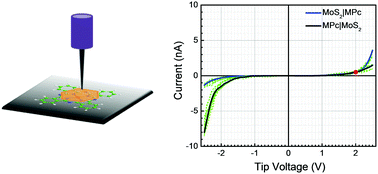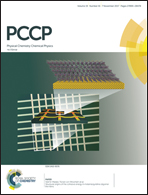Hybrid heterojunctions between a 2D transition metal dichalcogenide and metal phthalocyanines: their energy levels vis-à-vis current rectification†
Abstract
We form junctions between a monolayer of a range of metal-phthalocyanines and a monolayer of 2D transition metal dichalcogenides (TMD) through an electrostatic adsorption process. The energy levels of the components, as drawn from scanning tunneling spectroscopy (STS) and the density of states (DOS) thereof, indicated that the hybrid junctions would act as current rectifiers. We have observed that the central metal atom affected the energies of the metalorganics and thereby the rectification ratio of the junctions. In addition, since planar single molecule magnets (SMMs) were used in which magnetization appears due to the 3d-electrons of the metal, we could align the molecules followed by their structural immobilization. We have observed that such an alignment changed their molecular orbitals and hence affected the energy levels at the interface. The rectification ratio of molecule|TMD hybrid junctions depends on the metal in metalorganics and also on their alignment with the substrate electrode. In effect, the rectification ratio in a range of junctions has been correlated to the energy-level diagram at the interface.



 Please wait while we load your content...
Please wait while we load your content...